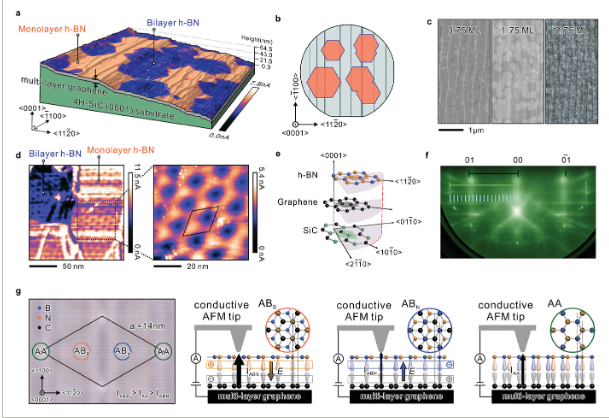Sheng-Shong Wong, Zhen-You Lin, Sheng-Zhu Ho, Chih-En Hsu, Ping-Hung Li, Ching-Yu Chen, Yen-Fu Huang, Kuo-En Chang, Yu-Chiang Hsieh, Chia-Hao Chen, Ming-Hao Lee, Ming-Wen Chu, Kuang-I Lin, Tse-Ming Chen, Yi-Chun Chen, Hung-Chung Hsueh薛宏中(淡江大學物理系), Cheng-Maw Cheng, Chung-Lin Wu

Related news: https://advanced.onlinelibrary.wiley.com/doi/10.1002/adma.202414442
Full Article: https://advanced.onlinelibrary.wiley.com/doi/10.1002/adma.202414442
This study utilized Molecular Beam Epitaxy (MBE) to grow controllable-layer h-BN thin films on graphene/SiC substrates. We then employed Angle-Resolved Photoemission Spectroscopy (ARPES) and first-principles calculations (including ground-state analysis with Density Functional Theory (DFT) and excited-state analysis with GW many-body perturbation theory corrections) to validate their interlayer polarization mechanism.
The research revealed that the Moire superlattice at the h-BN/graphene heterojunction induces spontaneous polarization. Furthermore, interlayer sliding enables reversible polarization switching, unequivocally demonstrating its ferroelectric properties. This breakthrough not only offers a novel pathway for the heteroepitaxy of two-dimensional ferroelectric materials but also opens new avenues for tunable electronic device applications.
This achievement, a result of close collaboration with experimental teams from National Cheng Kung University and National Taiwan University, as well as the National Synchrotron Radiation Research Center (NSRRC), showcases the integrated capabilities of Tamkang University’s Physics Department in theoretical and experimental research and provides students with opportunities to participate in cutting-edge international research.
